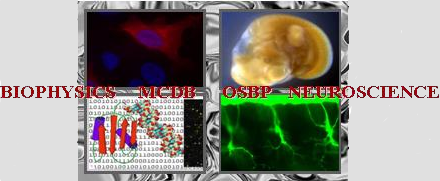Talk abstracts
Talk on Tuesday 03:00-03:15pm submitted by Monica Blatnik
Pnrc2-dependent mRNA decay and translational control mechanisms promote oscillatory gene expression during vertebrate segmentation
Monica C. Blatnik (Molecular, Cellular, and Developmental Biology), Thomas L. Gallagher (Department of Molecular Genetics), Sharon L. Amacher (Department of Molecular Genetics)
Abstract:
During early vertebrate embryogenesis, muscle and skeletal stem cells are grouped into reiterated segments, called somites, in a process called somitogenesis. Sequential somite formation is established by a genetic oscillator called the segmentation clock, comprised of a network of genes expressed periodically in the presomitic mesoderm. Precise control of segmentation clock oscillations is driven by robust temporal regulation of mRNA production, translation, and mRNA decay, and our work explores post-transcriptional mechanisms that regulate oscillatory expression. Proline-rich nuclear receptor coactivator 2 (pnrc2) regulates oscillatory mRNA decay in zebrafish embryos and loss of pnrc2 results in stabilization and accumulation of segmentation clock gene transcripts. However, pnrc2 mutant embryos exhibit normal segmentation clock protein expression and somite patterning is not disrupted. Polysome profiling was used to assess the translation state of segmentation clock gene transcripts her1, her7, dlc, and rhov, which revealed that all four transcripts were significantly increased in the ribosome-unbound (non-translating) state in pnrc2 mutants, compared to wildtype. Additionally, reporter analyses conducted to analyze the role of specific cis elements within the her1 3’UTR on mRNA stability and translation revealed that mutation of two regulatory elements, a Pumilio Response Element (PRE) and AU-rich Element (ARE), dramatically increased reporter transcript stability and polysome association, compared to the wildtype her1 3’UTR sequence. Pumilio and a subclass of ARE-binding proteins are known to promote mRNA decay and repress translation of their target transcripts. Our work investigating the role of RNA binding proteins, like Pumilio and ARE binding proteins, in regulating segmentation clock mRNA stability and translation will reveal how oscillatory gene expression is maintained to promote proper embryonic patterning.
Keywords: segmentation, oscillation, post-transcription
